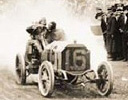MEMORANDUM OF CONDITIONS GOVERNING COMPETITION FOR THE TROPHY PRESENTED BY MR. WILLIAM K. VANDERBILT,
JR., TO BE ANNUALLY COMPETED FOR THROUGH THE AMERICAN AUTOMOBILE ASSOCIATION
ISSUED JUNE 8, 1904
First—Name, "The WILLIAM K. VANDERBILT, JR., Cup."
Second—To be competed for annually, beginning with 1904, through the American Automobile
Association, or its successor.
Third—Distance not less than 250 miles nor more than 300 miles. Course must be over a regularly
used highway; under no circumstances is the competition to be held on a track.
Fourth—Date: 1904, October 8. Entries closing on September 8th. 1905 and thereafter, between
August 15th and October 15th of each year. Challenges subsequent to 1904 must be filed before March 15th, entires
closing on that date. No postponements on account of the weather when the date is once set, by mutual agreement
between the holding and the challenging clubs.
Fifth—Those eligible to challenge and compete. Competition shall be allowed only to clubs that
are recognized by or affiliated with the American Automobile Association, and to clubs recognized by or affiliated
with the Automobile Club of France
Sixth—Number: Not more than ten cars shall represent any one country.
Seventh—During 1904 and 1905 the contest must be held in the United States. Subsequent to
1905 contest may be held within the country holding the Cup.
Eighth—Challenge Fee: Challenges must be accompanied by a fee of $300 for each car entered. Of
this sum $150 shall be refunded for each car starting. In the event of non-appearance, or failure to start,
the entire fee of $300 shall be forfeited to the holding club.
Ninth—Governing Rules: Contests each year are to be governed by the Road Racing Rules of the
American Automobile Association (when held in the United States) and the Road Racing Rules of the Automobile Club
of France (when held within a foreign country).
Tenth—Liability: When challenging, each contestant assumes (A) all expense incidental to his
participation and (B) all liability for criminal or civil suits for damages caused by him.
Eleventh—When the contest is held within the United States, the American Automobile Association
shall:
- 1st. Select and name the course to be covered.
- 2d. Secure necessary legislation or local government consent.
- 3d. Assume all expenses incidental to the above, and of all officials, control stations, marking the course,
etc., and, take in return all forfeited fees, and such portion of the entrance fee, as is not already provided for.
- 4th. Name the first, second, third and each succeeding car in the order of finishing, together with their times.
- 5th. Have the course thoroughly policed, turns suitably indicated, and danger points warned.
- 6th. Appoint all officials, with their credentials.
- 7th. Control all neutral zones.
Twelfth—When the contest is held within a foreign country, the Automobile Club of France shall
be charged with the foregoing duties.
Thirteenth—Turns shall be indicated as follows:
- Right. Red banner, right side of road, 100 yards before turn is reached. A second red banner on near right
side of corner.
- Left. Same as above, except blue banners.
Fourteenth—Straight-ahead-intersection. White banners placed as above.
- Straight-ahead-junction. Two white banners placed as above.
- Railroad Crossing. One hundred yards before (green banner).
- Sharp or Dangerous Decline. Yellow banner one hundred yards before reaching same.
Fifteenth—Neutral zones to be indicated by black streamers stretched across highways from a
fixed point with the number of the zone indicated by white letters, streamers to be three feet by ten feet,
letters at least eighteen inches high and not less than six inches in width, and bearing the word "Neutral."
Sixteenth—Controls shall be indicated by white streamers, similarly placed, of like dimensions,
with the word "Control" and the number of the said control consecutively arranged, in black; all letters and
figures to be not less than 18x6 inches.
Seventeenth—Commission: All contests shall be governed by a commission composed of the
following:
- 1904. The Racing Board of the American Automobile Association.
- 1905. The Racing Board of the American Automobile Association, the donor of the Cup, Mr. William K.
Vanderbilt, Jr., and one member of the Automobile Club of France, to be named by the President of the A. C. F.
During such succeeding years that the contest may be held within the United States the commission shall be constituted
as above.
During such years that the contest may be held on foreign soil, the commission shall be composed of the
following: the donor, Mr. William K. Vanderbilt, Jr., one member of the Racing Board of the American Automobile
Association, and the Sports Committee (or Racing Committee) of the Automobile Club of France.
Eighteenth—Numbering Cars: Competing cars must carry a distinguishing number arranged
consecutively, and drawn by lot after the date of the closing of the entries. The number so drawn shall indicate
the order of starting.
Nineteenth—Weight: There shall be no restriction as to the weight of competing cars, except that
they must weigh between 881 pounds and 2,204 pounds, and carry two passengers, seated side by side, whose weight
must be at least 132 pounds each.
Twentieth—Cars must be weighed in by official weighers on the day preceding the race
and equipment noted for checking when it appears at the starting line.
Twenty-first—Starting: Cars must start in the order of drawing. Cars will be started at 60
second intervals. Time of each car to be taken at the time fixed for its departure. Failure of the car to be
present at that moment will cause it to lose as much time as elapses from the time of the given start until the
moment it crosses the line.
Twenty-second—During the contests of 1904 and 1905 the first car will be started at daylight
or as soon as the commission deem it safe.
Instructions to the participants for the first Vanderbilt Cup race.
|



